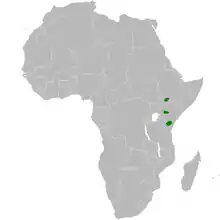Friedmann's lark
Friedmann's lark (Mirafra pulpa) is a species of lark in the family Alaudidae found in East Africa.
| Friedmann's lark | |
|---|---|
| Scientific classification | |
| Kingdom: | Animalia |
| Phylum: | Chordata |
| Class: | Aves |
| Order: | Passeriformes |
| Family: | Alaudidae |
| Genus: | Mirafra |
| Species: | M. pulpa |
| Binomial name | |
| Mirafra pulpa Friedmann, 1930 | |
 | |
| Synonyms | |
| |
Taxonomy and systematics
Formerly, some authorities considered Friedmann's lark to be a subspecies of the singing bush lark.[2] Alternate names for the species include Friedmann's bush lark, rufous lark and Sagon lark.
Description
It is best identified by its distinctive song; a long, drawn-out singular note, hoo-ee-oo (with slight stress on the ee), repeated at 1 or 2 second intervals. It is heard more often at night, and given while atop a bush or during undulating display flights.[3]
Distribution and habitat
Friedmann's lark is found in southern Ethiopia, central and south-eastern Kenya, and north-eastern Tanzania, but its population and exact range are very poorly known.[3] The type specimen was collected in Ethiopia (from the Konso-Sagan area) in 1992, having been seen only one time since, in 1998; but most of what is known comes primarily from data collected in Tsavo East and West National Parks, in Kenya.[3] There are also a few records from Tanzania, from Mkomazi Game Reserve, south of Arusha.[3]
In general, the natural habitats of Friedmann's lark are subtropical or tropical dry lowland grasslands.[4] Being aloof and shy, it apparently chooses the moister (or less dry), ranker-growing of these areas, and where it can find it, those with more bush-cover. This is in contrast to the more dry, and more open environs preferred by many other species of lark.[3]
Behaviour and ecology
It is nearly always witnessed only during certain times of year (in Tanzania, during rainy season, for example), to the exclusion of other times; and often amongst other migrant species. These observations would seem to suggest that it is a migratory bird, but more corroborating data is needed to make a definitive determination.[3]
Friedmann's lark appears to subsist mainly on small beetles, grasshoppers and other insects, as well as grass seeds.[3]
References
- BirdLife International (2012). "Mirafra pulpa". IUCN Red List of Threatened Species. 2012. Retrieved 26 November 2013.CS1 maint: ref=harv (link)
- "Mirafra pulpa - Avibase". avibase.bsc-eoc.org. Retrieved 2016-11-29.
- Phil Benstead, et al.; Friedmann's Lark - BirdLife Species Factsheet
- "Friedmann's Lark - BirdLife Species Factsheet (Additional Data)". BirdLife International. 2008. Retrieved May 6, 2009.
Cited works
- Compilers: Phil Benstead; Stuart Butchart; Mike Evans; Pete Robertson; Malcolm Starkey; Andy Symes; Contributors: John S. Ash; Neil Baker; Donald Turner (2008). "Friedmann's Lark - BirdLife Species Factsheet". Evaluators: Jeremy Bird, Stuart Butchart, Alison Stattersfield. BirdLife International. Retrieved May 6, 2009.
| Wikimedia Commons has media related to Mirafra pulpa. |
| Wikispecies has information related to Mirafra pulpa. |
